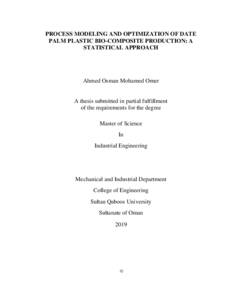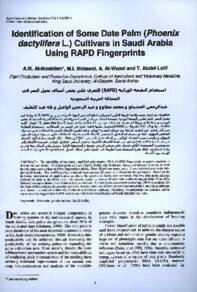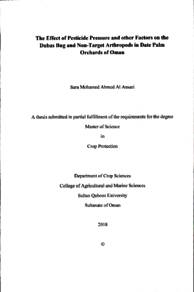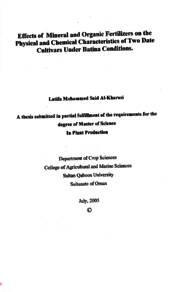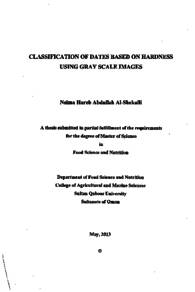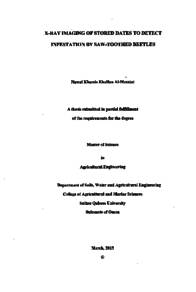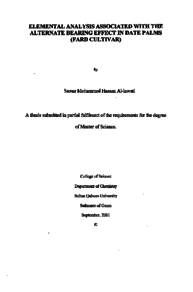وثيقة
PROCESS MODELING AND OPTIMIZATION OF DATE PALM PLASTIC BIO-COMPOSITE PRODUCTION: A STATISTICAL APPROACH
الناشر
Sultan Qaboos University
ميلادي
2019
اللغة
الأنجليزية
الملخص الإنجليزي
This research presents modelling process of date palm plastic composite in which date palm leaves flour (DPLF) used as a natural filler and two types of high density polyethylene (HDPE) (virgin & recycled) used as thermoplastic. DPLF selected, as it is abundantly available in Oman as agro residues, virgin and recycled (HDPE) studied to be compared in order to determine the differences between both forms. Bio-composite sheets produced under controlled processing parameters based on Central Composite Design (CCD) to develop a statistical model for response using fractional factorial design of experiment (DoE) procedure. The experimental design of bio-composites cover three different factors with three different levels; DPLF content (10, 20, and 30 v. %), coupling agent (2, 3.5, and 5 wt. %), and initiator (1, 1.5, and 2 wt. %). Significant factors affecting the behavior of products have been indicated. Moreover, the Response Surface Methodology (RSM) also adopted in the analysis of interactions among the input factors and their effect on overall mechanical properties of the fabricated composite. The Tensile and Flexural Strengths of specimens prepared according to ASTM standards measured by direct physical testing. Analysis of Variance (ANOVA) and Quadratic models used to develop mathematical models for the process responses. Finally, optimization using Design Expert software based on the nonlinear regression modeling is used to predict the optimal set of the studied parameters to produce optimized bio-composites with desired properties and cost effective. It is found that the developed bio-composites could serve as potential material in broad range of industrial applications as an environmentally friendly substitute to virgin and recycled HDPE.
الوصف
Thesis
المجموعة
URL المصدر
الملخص العربي
يقدم هذا البحث عملية النمذجة لمركب البلاستيك ونخيل التمر حيث يستخدم مطحون ورق نخيل التمر كألياف طبيعية مع نوعين من بوليمر البولي إيثلين عالي الكثافة )البكر والمعاد تدويره( المستخدم كلدائن حرارية. تم اختيار أورق نخيل التمر، لأنها متوفرة بكثرة في سلطنة عمان كمخلفات زراعية، تمت دراسة البولي إيثلين البكر والمعاد تدويره من أجل تحديد الاختلافات بين كلا النموذجين. صفائح المركب الحيوي التي يتم إنتاجها في إطار مُعاملات معالجة محكومة تعتمد على التصميم المركزي المركب لتطوير نموذج إحصائي للاستجابة باستخدام تصميم عاملي جزئي لتصميم التجربة. يغطي تصميم المستخدم للمركبات الحيوية ثلاثة عوامل مختلفة مع ثلاثة مستويات مختلفة، محتوى مطحون ورق نخيل التمر الحجمي 01 و 01 و 01 ( بالمئة، بالإضافة الى محتوى معامل الاقتران الحجمي ) 0 ( 0.3 و 3( بالمئة والمحتوى الحجمي لمحفز التفاعل ) 0 و 0.3 و 0( بالمئة. تم تحديد العوامل المهمة التي تؤثر على سلوك المنتجات، علاوة على ذلك، اعتمدت منهجية سطح الاستجابة أيضًا في تحليل التفاعلات بين عوامل المدخلات وتأثيرها على الخواص الميكانيكية العامة للمركب النهائي. يلي ذلك، اختبار هذه الالواح ميكانيكيا بقياس قوة تحمل الشد والانحناء حسب المعايير الدولية لقياس الخواص المذكورة للمركبات البوليميرية. وبعد تحليل هذه النتائج حسابيا فإنه يتم اختيار أكثر المكونات تأثيرا على هذه المركبات، ثم القيام بتحديد النسب الأفضل من العناصر التي تم تحليلها والمكونة لهذه المركبات في الدراسة لإنتاج مركبات حيوية محسّنة ذات خصائص مطلوبة وفعالة من حيث التكلفةلقد وجد أن المركبات المنتجة قد تعمل كمواد بديلة للبولي إيثلين في مجموعة واسعة من التطبيقات
الصناعية مع الاعتبار بأنها صديقة للبيئة.
الصناعية مع الاعتبار بأنها صديقة للبيئة.
قالب العنصر
الرسائل والأطروحات الجامعية

